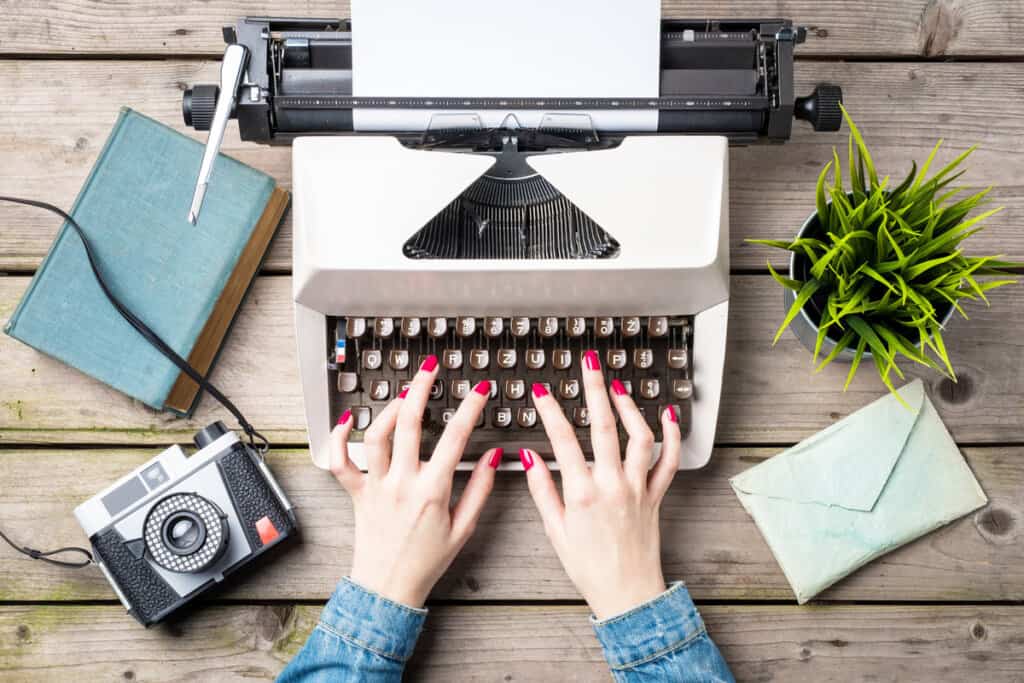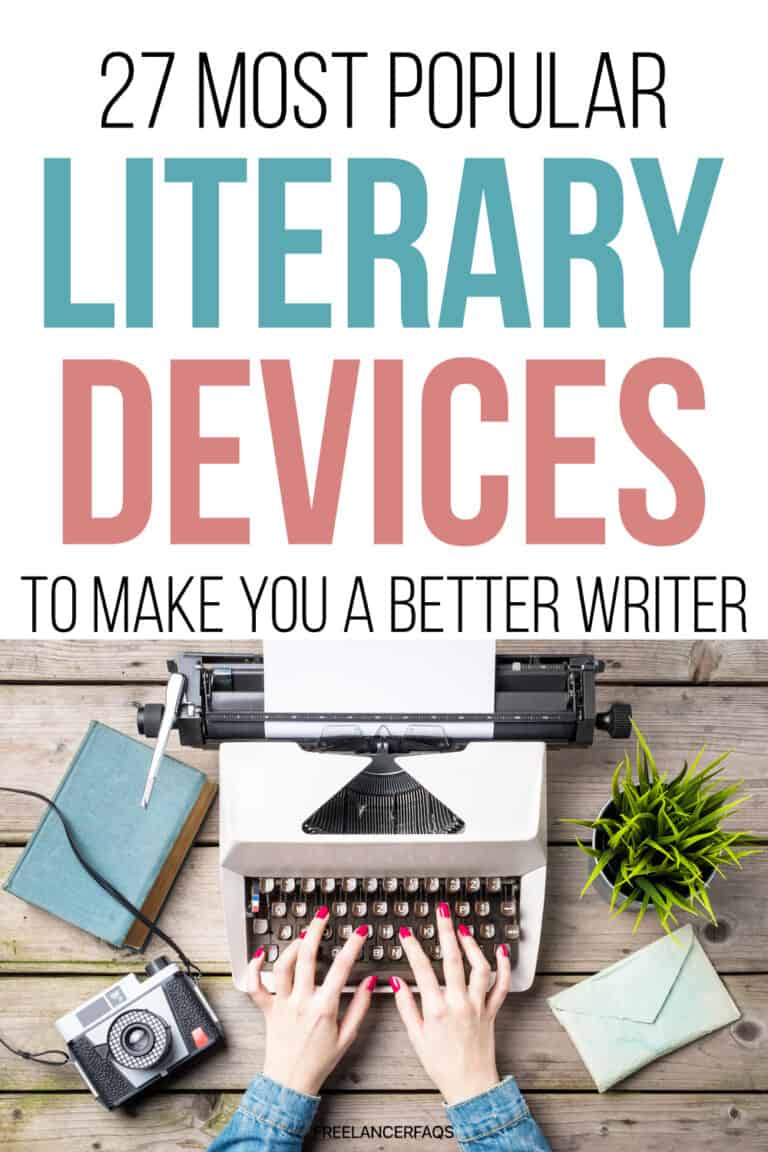Literary devices can be helpful in writing creative stories or personal essays that you are submitting to publishers.
Whether you’ve been writing for as long as you can remember or are new to the game, you can probably benefit from some literary device tips and tricks.

A literary device takes the reader beyond just the common and literal meaning of the writing and guides them in how to read the piece while sparking their imagination.
Before we jump into details and examples of literary devices, let’s just start with the basics, in case you have never heard of or knowingly used a literary device.
What Are Literary Devices?
Most of what we read in everyday writing is very straightforward, conversational type writing.
A literary device takes the reader beyond just the common and literal meaning of the writing and guides them in how to read the piece while sparking their imagination.
Using a literary device establishes a connection or relationship between things, either related or unrelated. They help to push the boundaries of how the reader interprets the written piece.
Comparison is often used as a literary device, more specifically similes and metaphors. We will get more into specifics of what these are and how to use them below.
The main goal of a literary device is to give the writing power and tap into the readers’ imagination and emotion.
There are many different types of literary devices and ways to use them in literature, poetry, and prose.
So first, let’s get started with a list of the most commonly used literary devices.
To help you with understanding these literary devices, make sure you pick up the Oxford Dictionary of Literary Terms.
This is a must for your writing.
Literary Elements
But before we jump into literary devices, let’s first take a look at literary elements that help to glue all of these literary devices together and their importance in the world of literature.
Literature, or text, is much like a house, it is made up of many different elements that individually don’t mean much, but when put together, they build something truly amazing.
These building blocks, used by authors, poets, screenwriters, and copywriters, are the literary elements that bring the text together and make it pop off the page.
Some of these literary elements you might be familiar with and others you might need a bit of a refresher on.
Character: Any being in a narrative that is not always human.
Dialogue: The direct talking between two or more characters.
Narrator: The “voice” that tells a story to the audience or reader.
Genre: General attributes of the story that determine technique, tone, content, etc. Such as fiction, horror, comedy, etc.
Plot: How the structure of the story unfolds.
Setting: Where and when, or the time and location of where the story takes place.
Theme: The overarching idea of the piece, such as personal growth, love, or politics.
Action: The physical change of characters or objects within the story.
Antagonist: The “bad guy” or the person who creates a conflict.
Protagonist: The “good guy” or the main character of the literature.
Conflict: The challenge a main character faces which they need to resolve to achieve their goal. (The protagonist and the antagonist are often at odds with one another over the conflict.)
Mood: the tone of the literature that is used to evoke certain emotions from the reader.
Before you can get into literary devices, such as allegories and symbolism, the literary elements need to be well established first.
List of Literary Devices
There are so many different literary devices that we could not possibly cover them all here. However, we will go over the most commonly used ones that help produce a special effect when writing a story or poem.
Here is a list of the most commonly used literary devices, we will cover what they are as well as literary device examples below.
Probably two of the most common literary devices that are used are the direct and indirect comparisons of metaphors and similes. These are also used very commonly in everyday language, even without realizing it.
1. Metaphor
A metaphor is a direct comparison of often two unrelated objects. The caveat here is that the words like and as are not used within the comparison.
“Your room is a pigsty!” This makes a direct comparison of the person’s room and that of a dirty, smelly pig pen.
2. Simile
A simile is the opposite of a metaphor. It is the indirect comparison of two objects. Opposite to the metaphor, the simile uses the words like and as.
“You eat like a pig.” The main difference is the presence or absence of the words like and as within the literary device. Metaphors are often used as a central device while a simile is supported.
3. Analogy
While metaphors and similes refer to comparisons of related and unrelated objects, an analogy argues that two different items are proportional. An analogy can be used in two different ways, to identify a shared relationship or to describe something unfamiliar using the description of a familiar item.
You are sure to have heard the expression, like finding a needle in a haystack.
This analogy is often used to compare finding something else that is very difficult.
Finding the perfect pair of jeans is like finding a needle in a haystack.
The structure of an analogy is often “A is to B.” Furthermore, as with other literary devices that can be used in conjunction with one another, an analogy can also be a simile or a metaphor.
4. Imagery
Imagery is used to build a sharper image of what is written in the text in the reader’s mind. It can be used both literally and figuratively and plays on both language and sensation to describe a person, place, thing, or idea.
Imagery is not simply used for visual representations but rather channels all five of the reader’s senses. By appealing to sight, sound, touch, smell, and taste, the author creates a vibrant world that the reader can step into.
5. Symbolism
Symbolism combines both the literary devices of imagery and metaphors. Symbols and symbolism are everywhere we look in our everyday lives and we often use symbolism in our day-to-day language without even realizing it.
An American flag is a symbol of freedom and patriotism. A four-leaf clover symbolizes good luck. And a dollar sign symbolizes money and wealth.
6. Hyperbole
Simply put, hyperbole is a way of dramatizing everything. People often use hyperboles in their everyday speech without even realizing it. These are meant to be dramatizations and not be taken literally.
For example, when someone is so hungry they say I’m so hungry I could eat a horse!
This is a simple hyperbole that infers that they are very hungry and could eat a lot of food.
7. Personification
This is an easy one, it’s simply giving something that is not human, human attributes. It is also referred to as anthropomorphism but is a great way to evoke empathy from readers.
For example, the leaves danced in the wind as they floated down to the ground.
8. Irony
Ironically, people often misuse irony in speech and as a literary device. Most often the irony that we think of is just dark humor. Irony is when an author uses the opposite language to describe something. One of the greatest examples of literary irony is The Wizard of OZ where the characters make a long journey to ask the wizard for what they already possessed.
9. Paradox
A paradox is a self-contradictory statement that sounds seemingly absurd but when explained to the reader, proves to be well-founded. This can happen when two seemingly opposite forces are at war with one another.
For example, the ability to love and hate a person at the same time.
Not to be confused with the oxymoron, which is a play on words, a paradox is assumed to be true.
More Common Literary Devices
 True to their form, literary devices are just ornate words for simple writing concepts.
True to their form, literary devices are just ornate words for simple writing concepts.
Here are a few more decorative words for common literary devices:
10. Allusion
A literary reference where the author is alluding or hinting to something.
11. Allegory
A story that’s purpose is to represent an idea or abstract concept, can be used as an extension of an allusion.
12. Ekphrasis
The verbal representation of a visual representation, in other words…a piece of writing that is inspired by another piece of art.
13. Onomatopoeia
A descriptive word that sounds like the noise it makes. Bang!
14. Pun
Used as a humorous anecdote that plays on the meanings and sounds of words to produce a funny, new idea.
Literary Devices in Poetry
15. Juxtaposition
What a fun word to say…
Juxtapositions are often used in poetry and prose to produce a thought provoking or ironic effect. These are used to build tension with the placement next to each other of two contrasting ideas.
Some common juxtapositions that you might hear are:
Beggars can’t be choosers.
Better late than never.
When the cat’s away the mice will play.
16. Rhyme
Rhyming is very common in poetry. Think about Dr. Suess or Shel Silverstein.
Pretty much everything they wrote had some sort of rhyming to it. Often the ending word of a verse rhymes with the ending word of the next verse and so on.
Other Common Literary Devices in Poetry
Here are 11 more examples of literary devices used in poetry and commonly appear in verses.
17. Alliteration
Alliteration is a literary device in which a series of words begin with the same sound.
For example, “She sells seashells by the seashore.”
This technique is often used in poetry to create a pleasing, musical effect. It can also be used to help readers remember a series of words or to emphasize certain words.
18. Anaphora
Anaphora is a word or phrase that is repeated at the beginning of several consecutive clauses or sentences.
Here is an example of using an anaphora in a sentence.
“We shall fight on the beaches, we shall fight on the landing grounds, we shall fight in the fields and in the streets, we shall fight in the hills.”
This technique is often used for emphasis or to create a rhythm and make your writing more engaging to read.
19. Apostrophe
An apostrophe is a literary device in which a character in a story or poem speaks directly to an object, usually one that is not alive.
For example, “O rose, how sweet you smell!”
In this case, the character of the rose is being addressed directly. This type of literary device can be used to create a more intimate or personal feel to a story or poem.
20. Conceit
A conceit occurs when the author creates an extended metaphor, usually involving unlikely comparisons.
As an example of this, John Donne’s “A Valediction: Forbidding Mourning” is a poem about two lovers who are separated but who remain connected through their love.
The entire poem is a conceit comparing their love to a mathematical equation.
This can be used to create a more creative or unusual way of looking at a situation or relationship.
21. Consonance/Assonance
Consonance is a literary device in which a series of words contain the same or similar consonant sounds.
“I scream, you scream, we all scream for ice cream!”
This literary device can be used to create a rhythm or to emphasize certain words.
Assonance is similar to consonance but involves the repetition of vowel sounds.
For example, “I found a sound in the ground.” This technique can also be used to create a rhythm or to emphasize certain words.
22. Enjambment
Enjambment occurs in a sentence or clause that runs on into the next line without a pause. Here’s an example, “The trees are green and the sky is blue.”
This can be used to create a feeling of movement or to keep the reader’s attention focused on the story or poem.
23. Euphony/Cacophony
Euphony happens in which the sounds of the words are pleasing to the ear. For example, “The softest whisper can be heard miles away.” You can use this in your writing to create a calming or soothing effect for the people reading your story or poem.
Cacophony, on the other hand, is a literary device in which the sounds of the words are harsh or unpleasant. “The sound of the drums was deafening.” This technique can be used to create a feeling of chaos or confusion.
24. Meter
Meter is the rhythm of the words and is measured by the number of syllables or stressed and unstressed beats. For example, “The stones skip across the water.” This type of writing can be used to create a feeling of movement or to keep the reader’s attention focused on the story or poem.
25. Metonymy/Synecdoche
Metonymy is a literary device in which one word or phrase is used to represent another.
As an example, “The White House said today that the president will not be attending the summit.”
In this case, “The White House” is being used to represent the president and his staff.
Doing this can save time or to make a statement more concise.
Synecdoche is a type of metonymy in which a part of something is used to represent the whole.
For example, “All hands on deck!” In this case, “hands” is being used to represent the people who are working on the deck.
This can be used to create a sense of urgency or to emphasize the importance of a task.
26. Repetition
Repetition occurs in which a word or phrase is repeated multiple times.
For example, “Your shoes are your shoes, and your socks are your socks.”
This would do this to create a feeling of emphasis and to let the reader know to pay attention to why you repeated that phrase.
27. Zeugma
Zeugma is when one word is used to modify two or more other words. “She lost her keys and her temper.”
The word “lost” is modifying both “keys” and “temper.”
This can be used to create a more concise statement or to make a statement more interesting.
Wrap Up
By understanding and using these literary devices, you can create a more intrigue in your writing which adds another element to hook a reader into your content.
Each device allows you to explore different ways of looking at the world and can be used to create a specific effect.
Try out some of these in your own writing and see how they can improve your work and let me know in the comments!




1 Comments